Plastids and types - Study guides, Class notes & Summaries
Looking for the best study guides, study notes and summaries about Plastids and types? On this page you'll find 95 study documents about Plastids and types.
Page 2 out of 95 results
Sort by

-
BOT 331 - Plant Physiology Test Questions With Complete Solutions
- Exam (elaborations) • 9 pages • 2024
- Available in package deal
-
- $13.99
- + learn more
BOT 331 - Plant Physiology Test Questions With Complete Solutions There are two types of nucleic acids: DNA and RNA. There is both DNA and RNA inside the nucleus, mitochondria and plastids. Is there both DNA and RNA in the cytosol? Explain your answer No, not both. DNA remains in the nucleus. RNA copies of genes are synthesized in the nucleus, but then moved out pores into the cytosol, where ribosomes (also containing RNA) bind RNA and use the RNA to direct synthesis of proteins. In...
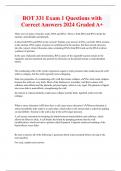
-
BOT 331 Exam 1 Questions with Correct Answers 2024 Graded A+
- Exam (elaborations) • 26 pages • 2024
- Available in package deal
-
- $13.49
- + learn more
BOT 331 Exam 1 Questions with Correct Answers 2024 Graded A+ There are two types of nucleic acids: DNA and RNA. There is both DNA and RNA inside the nucleus, mitochondria and plastids. Is there both DNA and RNA in the cytosol? Explain your answer No, not both. DNA remains in the nucleus. RNA copies of genes are synthesized in the nucleus, but then moved out pores into the cytosol, where ribosomes (also containing RNA) bind RNA and use the RNA to direct synthesis of proteins. In the ...
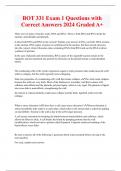
-
BOT 331 Exam 1 Questions with Correct Answers 2024 Graded A+
- Exam (elaborations) • 26 pages • 2024
-
- $12.99
- + learn more
BOT 331 Exam 1 Questions with Correct Answers 2024 Graded A+ There are two types of nucleic acids: DNA and RNA. There is both DNA and RNA inside the nucleus, mitochondria and plastids. Is there both DNA and RNA in the cytosol? Explain your answer No, not both. DNA remains in the nucleus. RNA copies of genes are synthesized in the nucleus, but then moved out pores into the cytosol, where ribosomes (also containing RNA) bind RNA and use the RNA to direct synthesis of proteins. In the ...
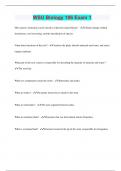
-
WSU Biology 106 Exam 1
- Exam (elaborations) • 13 pages • 2024
- Available in package deal
-
- $9.99
- + learn more
WSU Biology 106 Exam 1 Most species extinction can be traced to what four major threats? - Climate change, habitat destruction, over harvesting, and the introduction of species. Name three functions of the root? - Anchors the plant, absorbs minerals and water, and stores organic nutrients. What part of the root system is responsible for absorbing the majority of minerals and water? - The root hair. What two components create the stem? - Internodes and nodes. What are nodes? - T...
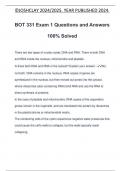
-
BOT 331 Exam 1 Questions and Answers 100% Solved
- Exam (elaborations) • 13 pages • 2024
-
- $11.49
- + learn more
BOT 331 Exam 1 Questions and Answers 100% Solved There are two types of nucleic acids: DNA and RNA. There is both DNA and RNA inside the nucleus, mitochondria and plastids. Is there both DNA and RNA in the cytosol? Explain your answer - No, not both. DNA remains in the nucleus. RNA copies of genes are synthesized in the nucleus, but then moved out pores into the cytosol, where ribosomes (also containing RNA) bind RNA and use the RNA to direct synthesis of proteins. In the case of plasti...
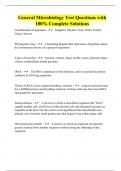
-
General Microbiology Test Questions with 100% Complete Solutions
- Exam (elaborations) • 7 pages • 2024
-
Available in package deal
-
- $13.99
- + learn more
Classification of organisms - Kingdom, Phylum, Class, Order, Family, Genus, Species Phylogenetic trees - a branching diagram that represents a hypothesis about the evolutionary history of a group of organisms Types of microbes - bacteria, archeae, fungi, molds, yeasts, protozoa, algae, viruses, multicellular animal parasites rRNA - The RNA component of the ribosome, and is essential for protein synthesis in all living organisms. Theory of RNA as the original hereditary ma...

-
BIO 101 STUDY GUIDE LATEST REVIEW TO SHARPEN YOUR SKILLS
- Other • 14 pages • 2024
-
Available in package deal
-
- $8.49
- + learn more
• Cell: The basic structural and functional unit of every organism. • Types of Cells o Prokaryotic [Archaea & Bacteria] o Eukaryotic [Animals, Plants, Fungi] • All cells have o Plasma Membrane o Cytoplasm o Chromosomes [contain genes] – Made of Chromatin o Ribosomes [make proteins] – Made of RRNA & Protein • Prokaryotic Cells [Smaller] o No nucleus o DNA in nucleoid o No membrane bound organelles • Eukaryotic Cells [Larger] o DNA in a nucleus bounded by a double membr...
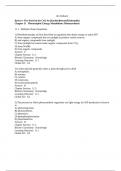
-
Becker's The World of the Cell, 9e(Hardin/Bertoni/Kleinsmith)Chapter 11Phototrophic Energy Metabolism: Photosynthesis
- Other • 135 pages • 2023
-
- $25.49
- + learn more
11.1 Multiple-Choice Questions 1) Photoheterotrophs are best described as organisms that obtain energy to make ATP A) from organic compounds but use sunlight to produce carbon sources. B) and organic compounds from sunlight. C) from sunlight but cannot make organic compounds from CO2. D) from NADH. E) from organic compounds. Answer: C Chapter Section: 11.1 Bloom's Taxonomy: Knowledge Learning Outcome: 11.1 Global LO: G2 2) Carbon dioxide generally enters a plant through pores called...

-
Test Bank for Biological Science Canadian Edition 2nd Edition by Scott Freeman, Michael Harrington, Joan C. Sharp
- Exam (elaborations) • 1121 pages • 2024
-
- $17.99
- + learn more
Test Bank for Biological Science, Canadian Edition 2nd Edition by Scott Freeman, Michael Harrington, Joan C. Sharp. Contents Chapter 1 Biology and the Tree of Life 1 1.1 The Cell Theory 2 Are All Organisms Made of Cells? 2 Where Do Cells Come From? 2 1.2 The Theory of Evolution by Natural Selection 4 What Is Evolution? 4 What Is Natural Selection? 4 1.3 The Tree of Life 5 Linnaean Taxonomy 6 BOX 1.1 Scientific Names and Terms 6 Using Molecules to Understand the Tree of Life 8 1.4 Doing Biology 1...
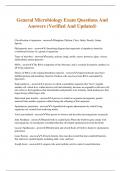
-
General Microbiology Exam Questions And Answers (Verified And Updated)
- Exam (elaborations) • 4 pages • 2024
- Available in package deal
-
- $10.49
- + learn more
General Microbiology Exam Questions And Answers (Verified And Updated) Classification of organisms - answerKingdom, Phylum, Class, Order, Family, Genus, Species Phylogenetic trees - answera branching diagram that represents a hypothesis about the evolutionary history of a group of organisms Types of microbes - answerbacteria, archeae, fungi, molds, yeasts, protozoa, algae, viruses, multicellular animal parasites rRNA - answerThe RNA component of the ribosome, and is essential for protein...

Did you know that on average a seller on Stuvia earns $82 per month selling study resources? Hmm, hint, hint. Discover all about earning on Stuvia


